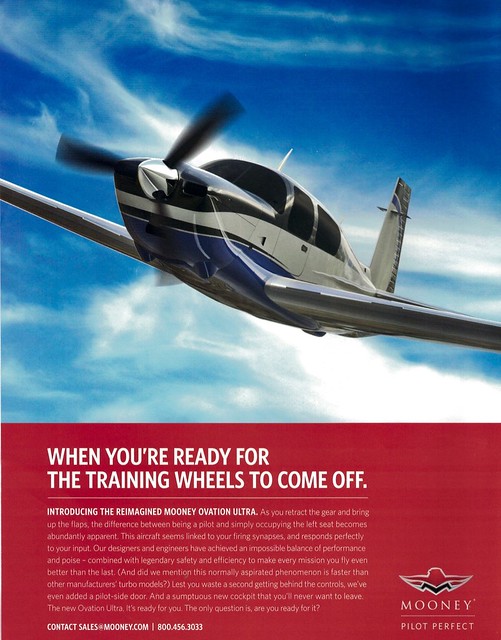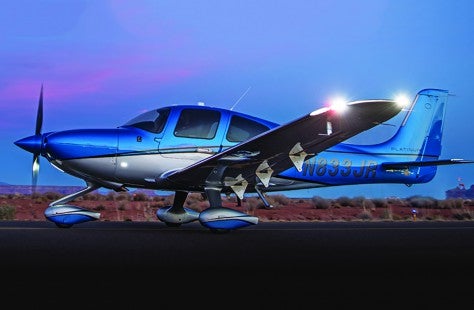dell30rb
Final Approach
But they still have training wheels!

Haven't seen this... way to go Mooney! Hilarious.
Honestly though I don't think they will be able to compete unless they add a parachute.
But they still have training wheels!

I was always surprised that function didn't exist before! Something I always wished I could do with my 182. Especially because at times I'll return from a work trip late at night, want to go on an IFR flight the next day but can't get to the hangar to get the cards update em etc. now you can just do it when you want to go flying. Glad to see that they finally came up with such a thing in today's day and age
@mulligan now that the word is out can you share what options your bird will be getting?!
You have to admit they are very common. There are probably 20 of them based at my home field. I like them because I think they are practical - at least the older ones that don't cost a fortune.
However, Cirrus does seem to have their clientele figured out. I know a wealthy guy who gets a new one every other year. No practical reasons just likes the new paint, interiors and what not. I am sure he could afford something that burns Jet-A but he likes the Cirrus brand and its something you can do on weekends. I guess these are the same people who buy Ferraris etc...

@mulligan now that the word is out can you share what options your bird will be getting?!

Another thing Cirrus does better than anyone is marketing to the wives. The safety aspects of the parachute and blue level button are such a powerful marketing tool to them. Even the comfort of a luxury SUV and car like environmental controls (on the co-pilot side of course) are all geared towards our better halves.
I know a few Cirrus drivers who want to get turbines, but their wives are vetoing them because it "doesn't have a chute". When I started looking into flying I had never even heard of Cirrus before, but when I brought up flying to my wife she said I could only do it if I flew the plane with a chute. wtf
As you can see I now fly a Cirrus. #MarketingWin
It's fast and relatively efficient.
We went with the SR22 NA FIKI GTS with Oxygen as well with Carbon Agate/Sterling. When's your delivery date? We'll be down there the week of Feb 6th.
But they still have training wheels!
Haven't seen this... way to go Mooney! Hilarious.
Honestly though I don't think they will be able to compete unless they add a parachute.
[...] I got the SR22 NA FIKI GTS with Oxygen. [...]
Wow, very nice![...] We went with the SR22 NA FIKI GTS with Oxygen as well with Carbon Agate/Sterling. [...]

There dont seem to be many NA FIKI planes on the used market. Either they are uncommon or those who have them dont have a reason to sell.
I do love the fact that I will be able to do my database updates from my iPad! I know its no big deal, but now I have to go to the hangar, grab the cards, bring them to the office or house, do the downloads, go back to the hangar and do the updates and hope nothing goes wrong. Now I can just update my iPad using the Garmin App and head to the plane, turn a switch and it will upload the new databases while I pre-flight.
With a ~$1M price tag - I can't believe they don't put a LTE Card in these for cellular downloads. I'm sure those that can afford a plane line this wouldn't flinch at a $15 data plan.. not to mention all the other stuff you could get with it (weather, flight plan, etc)
Wow. Close to a million bucks for a fixed gear, single piston engine airplane. It's hard not to have a "That's bonkers" reaction.
I'm glad they sell - rich GA pilots are pilots all the same, and we need as many as we can get. But I'd still take my 50 year old twin into low IFR, or over high terrain, or at night/over water anytime, and the Cirrus I simply... wouldn't.
I don't think a Twin has any safety benefits over a chute, save for over-water flights. There are pros and cons to each that basically cancel each other out. There have been enough chute pulls to show that it works, even over rough terrain. Its simple and harder to screw up than having engine failures in a twin. You are twice as likely to have an engine failure in a twin. With the cirrus you get all of the performance benefits of a single and you have an "oh ****" red handle as long as you are above 800' agl or so, coincidentally about the same time you are well above blue line and the gear and flaps are up in a twin.
I do love the fact that I will be able to do my database updates from my iPad! I know its no big deal, but now I have to go to the hangar, grab the cards, bring them to the office or house, do the downloads, go back to the hangar and do the updates and hope nothing goes wrong. Now I can just update my iPad using the Garmin App and head to the plane, turn a switch and it will upload the new databases while I pre-flight.
With a ~$1M price tag - I can't believe they don't put a LTE Card in these for cellular downloads. I'm sure those that can afford a plane line this wouldn't flinch at a $15 data plan.. not to mention all the other stuff you could get with it (weather, flight plan, etc)
@mulligan now that the word is out can you share what options your bird will be getting?!
Amortize all the costs - purchase, insurance, maintenance, etc - not just fuel and time over the entire time you will own the Cirrus.Incredibly efficient.
Case in point:
S. FL to N GA in my Tiger: 5 hours at 10 gph and 133k, 50 gals and almost always a fuel stop.
Same flight in my SR22: 3.5 hours at about 13.5 gph and 170k. 47 gals and never a fuel stop.
An hour and a half quicker on slightly less fuel. And the Tiger itself is no slouch in the efficiency department!
Amortize all the costs - purchase, insurance, maintenance, etc - not just fuel and time over the entire time you will own the Cirrus.
Not even close, sir. There's no comparison to having a second engine -- the chute is a very poor competitor to true multi-engine redundancy. There have been holy wars over this at the Red Board, and it's not my intent to recreate that here, but you won't find even a shred of agreement from me on that subject. I treat the Cirrus the same as I would any other single engine airplane when it comes to pre-flight planning and contingency considerations, and I don't give any weight to the fact that the BRS is installed.
"Twice as likely to have an engine failure in a twin" is an OWT which has been beaten (and debunked) to death in many years of message board debates, BTW.
I believe the probability of a failure doubles.
So the SR-TwentyTwin will come out and make the whole world a happy place, then what argument would one have?!
DA-62 comes close! Auto feather and a high single engine service ceiling certainly tips the scales.
This. It's a wives plane. They see comfortable leather seats, big windows, a parachute, and climate control that looks like it belongs in a car. It feels familiar to them and Cirrus does a great job marketing it.Another thing Cirrus does better than anyone is marketing to the wives. The safety aspects of the parachute and blue level button are such a powerful marketing tool to them. Even the comfort of a luxury SUV and car like environmental controls (on the co-pilot side of course) are all geared towards our better halves.
I know a few Cirrus drivers who want to get turbines, but their wives are vetoing them because it "doesn't have a chute". When I started looking into flying I had never even heard of Cirrus before, but when I brought up flying to my wife she said I could only do it if I flew the plane with a chute. wtf
As you can see I now fly a Cirrus. #MarketingWin
DA-62 comes close! Auto feather and a high single engine service ceiling certainly tips the scales.
The new DA-42 actually has a higher single engine ceiling. The SR22-G5 and the DA-42-VI actually very closely compare.
I thought the DA42 was/is pretty weak in the useful load department.
Okay, I need an airplane in this color in my life. If I got one it wouldn't even be a question. I wonder how hard it is to transfer an N number? If I got a new bird I wouldn't give up my N number, I'd like to keep it, actually that's a requirement for me
